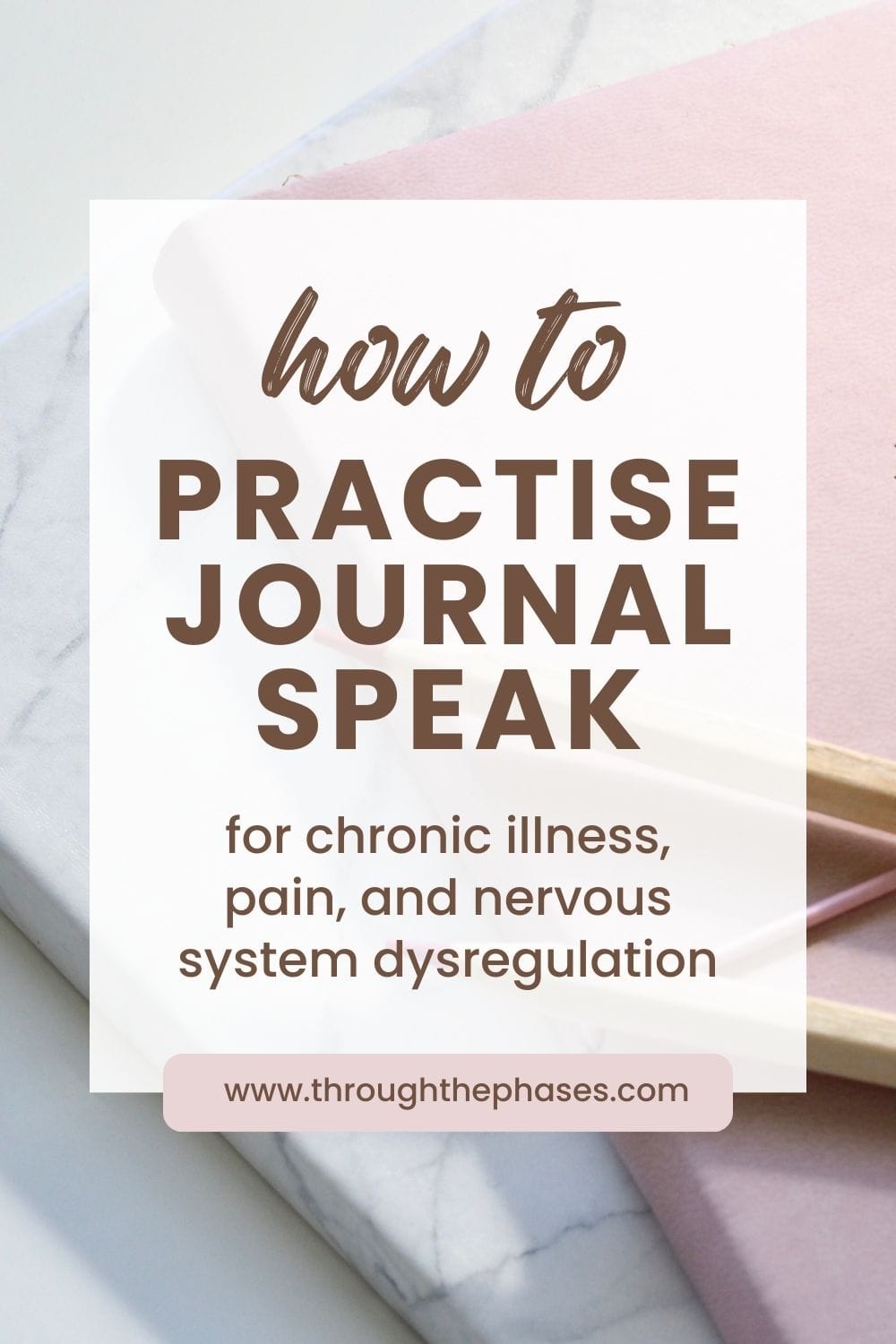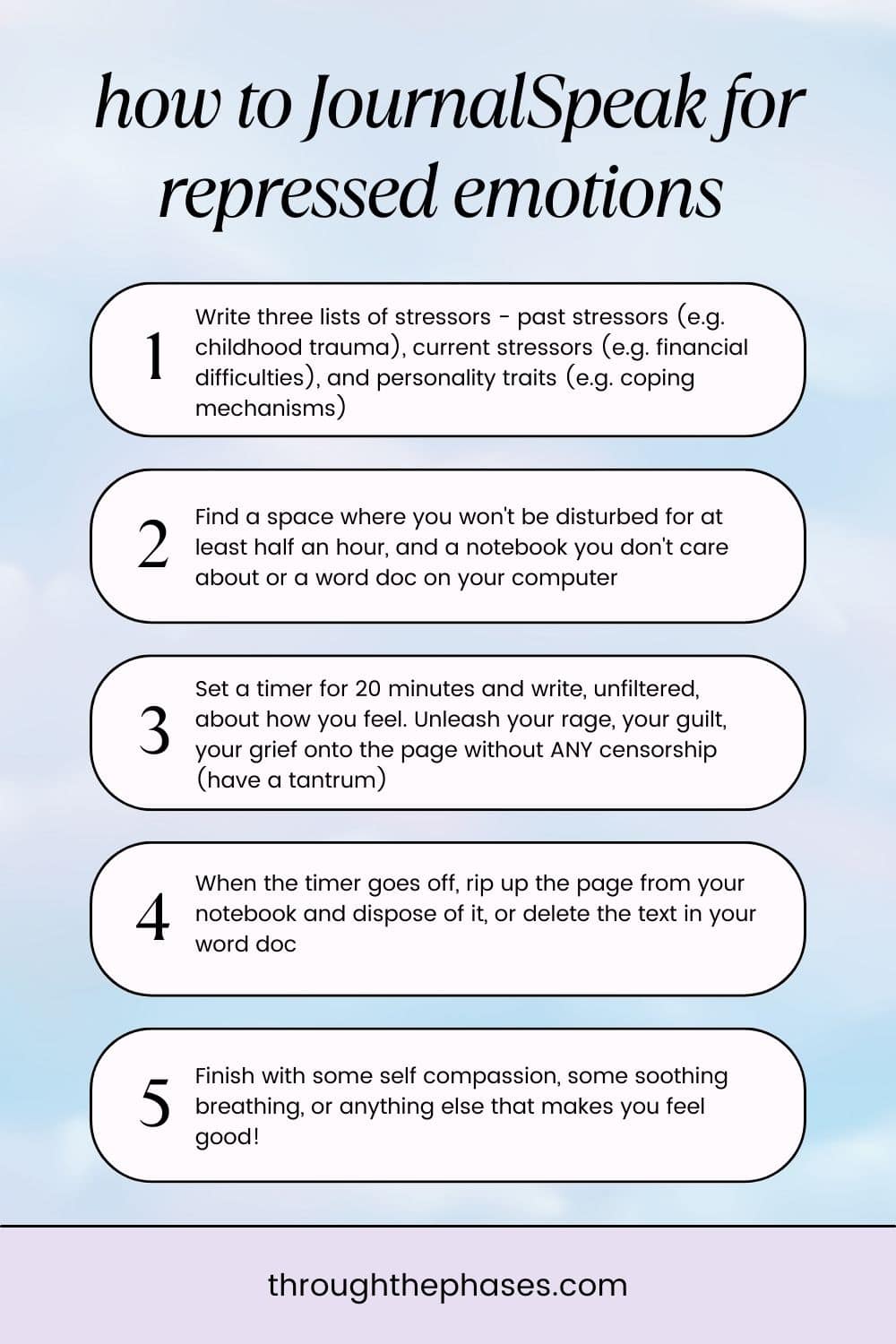Journaling has been an amazing tool for me throughout my healing journey, but even more so since the development of my chronic physical symptoms.
Since learning about the impact of suppressed emotions and trauma on my body and nervous system, I’ve turned to journaling in times when I’ve felt the need to release emotions and express my thoughts freely.
JournalSpeak is a specific journaling technique that is designed to help you do just that.

JournalSpeak, often referred to as “rage on a page” is a journaling technique that many sufferers of chronic symptoms swear by to find relief (and even fully recover) from their chronic conditions.
In this post I’ll be helping you understand the impact of journaling for chronic symptoms and how to practise JournalSpeak specifically.
My hope is that by the end you will have a good idea of whether or not this technique is something you wish to try in your own life for relief from chronic pain or illness, and you’ll have everything you need to start your own JournalSpeak practice.
So without further ado, let’s get stuck in.

This post may contain affiliate links. Click here to read my full disclosure.
The role of the nervous system, trauma, and emotions in chronic conditions
The nervous system plays a huge role in the development and ongoing nature of chronic symptoms, especially in “mind-body disorders” like Chronic Fatigue Syndrome, Fibromyalgia, Tension Myositis Syndrome, IBS and POTS (along with other types of dysautonomia).
In chronic illnesses like these, a dysregulated nervous system can contribute to a vicious symptom cycle through an “overactive” stress response, poor emotional regulation, heightened pain perception, inflammation, gut abnormalities, automatic brain associations (neural pathways) and poor sleep, among other things.
This can be an incredibly hard cycle to get out of. The more symptoms we experience, the more stressed we feel. The more stressed we feel, the more symptoms…
But why does this start to begin with?
For many people with chronic symptoms, conditions develop through a perfect storm of physical and environmental factors such as prolonged stress, some kind of physical illness or infection, or trauma (or, in many cases, all of the above).
In other words, the system enters a state of survival due to certain factors, but it struggles to “bounce back”.
And those of us with chronic symptoms are kinda stuck in this survival state long-term.
I know, in my case, my physical symptoms were brewing in some capacity my entire life due to developmental traumas and emotional repression.
For instance, I’ve had IBS symptoms, fatigue and anxiety since childhood.
Then, when I experienced an extreme physical trauma at 23 years old, and, not long after, got the dreaded virus we shall not name… more extreme and chronic symptoms hit that would later be diagnosed as dysautonomia.
And, as it turns out, my story is not very unique when it comes to chronic illness or chronic pain.

What is TMS personality?
When it comes to chronic pain specifically, Dr. John Sarno pioneered the term Tension Myositis Syndrome (TMS) to describe chronic pain conditions that were not otherwise explained by pathological or structural abnormalities.
In other words, the pain is psychosomatic, resulting from the mind-body connection.
Note: this does not mean that the pain and symptoms are not REAL. Instead, it means that the physical pain is caused by psychological and emotional factors, particularly repressed emotions.
According to Dr. Sarno, sufferers of TMS and other chronic conditions often have a set of “personality traits” that are thought to contribute to chronic symptoms.
Such personality traits include perfectionism, a strong sense of responsibility or independence and a tendency to suppress emotions.
All of these traits are thought to be coping mechanisms to deal with stress, but paradoxically, create more stress and dysregulation in the body and nervous system.
Dr. Sarno suggests that chronic symptoms are yet another one of these coping mechanisms that actually serve as a function to distract an individual from the underlying emotional turmoil or trauma that they are so desperately trying to avoid.
If you want to read more about Dr. Sarno’s theory on TMS personality, you can read some of his key books Healing Back Pain, The MindBody Prescription and Divided Mind below:
Personally, I think Dr. Sarno’s theory is slightly reductionist in nature, but I DO believe that there is some level of truth to it.
I don’t think it’s a coincidence that many of us with chronic conditions do have these similar tendencies, especially the tendency to suppress emotions.
And from my own journey with mindbody healing I have experienced huge improvements from focusing on trauma work and emotion release, and witnessed amazing recovery journeys from others on a similar path.
So, if you’re suffering from chronic pain or other chronic symptoms, this theory is certainly something to consider.

The benefits of journaling for chronic symptoms
So, now that we’ve got the theory bit out of the way, how does journaling come into this?
Believe it or not, journaling is a really beneficial tool when it comes to chronic symptoms, for many different reasons.
Before I get into JournalSpeak, which is a specific journaling technique for this purpose, here are some key benefits of journaling for chronic symptoms:
- Emotional processing: writing about feelings, including those related to chronic illness, gives us the space to reflect and process tricky emotions like frustration, grief, and loss
- Emotional release: journaling out our emotions can help to release them from the body, reducing emotional stress and dysregulation
- Increased self-awareness: writing can help to gain insight into thoughts, feelings and behaviours, as well as identifying key patterns, triggers and stressors that might be contributing to chronic symptoms
- Progress tracking: journaling can help to reflect on our progress and our wins, particularly during challenging times. It can be helpful to look back and see how far you’ve come, especially when you’re in a setback
- Mind-body connection: writing about our experience gives us the opportunity to explore the connection between our thoughts, feelings and sensations. This can deepen our mind body connection and facilitate deeper healing

What is JournalSpeak?
By now you should have a good understanding about the role of emotions in chronic conditions, as well as some benefits of journaling for chronic symptoms.
So, what is JournalSpeak specifically?
JournalSpeak is an expressive writing journaling technique developed for chronic pain conditions, like TMS, by Nicole Sachs, a psychotherapist in the field of mindbody healing, author of The Meaning of Truth, and creator of The Cure For Chronic Pain podcast.
Nicole Sachs, who describes herself as a disciple of Dr. John Sarno, believes that by giving our emotions a “steam valve” (through journaling), the mindbody system can find equilibrium, we can move out of fight or flight mode, and our brains no longer have to produce symptoms in order to “distract” us from said emotions.
The premise is really quite simple, and is basically a form of “free writing” that I talk about often in my posts.
The idea is to write freely, expressing your emotions (with a focus on those difficult ones that you often bury down!), without judgement and without censorship.
There is often a focus on expressing repressed anger which is why it is sometimes nicknamed “rage on a page”, but any emotion that needs to be expressed can be expressed, especially anything that causes you to feel shame.

How to practise JournalSpeak step-by-step
So how do you get started with JournalSpeak?
Well, as I already mentioned, it’s really very simple.
Follow this step-by-step to try this technique out for yourself.
1. Get a notebook you don’t care about or your computer
Start by grabbing a notebook that you don’t care about. I personally think a great choice is something like a “refill pad” where you can easily tear out the page when you’re done.
You can also use a computer/laptop, however.
I actually personally prefer to do this exercise on my laptop because I feel like I can type much faster than I can write. This allows me to really get the words out as they flow into my consciousness.
Choose whatever works best for you – you can always experiment and change it up if something’s not working.
2. Find a quiet safe place
Take yourself to a place where you won’t be disturbed for at least half an hour or so.
This is important because the idea of this practice is to avoid self-censorship.
Having someone in the room or nearby will make you more self conscious about what you’re expressing. If you know you’re alone you will more freely be able to engage in the practice.
3. Set a timer for 20 minutes and turn it over
Set a timer for 20 minutes.
Ideally, you want the timer to be out of sight so that you’re not tempted to check the time. So if you’ve set it on your phone, make sure to turn it over.
I personally like to set the timer on my smart watch.
This is because the timer on my watch goes off with a gentle vibration on my wrist, whereas a phone timer almost always makes me jump!
If you have a sensitive nervous system (which many of us with chronic symptoms do) consider setting a more gentle timer if possible or turning the volume right down on your device.
4. Write unfiltered until the timer goes off (or until you come to a natural close)
Now all you have to do is write and express yourself, without censorship, until the timer goes off.
The idea is to express any emotions that need to be expressed, but I’ll cover what to write about in just a moment.
The most important thing is to really dig into those core feelings and emotions and to express them to their full capacity.
If you truly connect to the emotion you’ll often find that it seems like a much younger mentality. It speaks in extremes, almost like a child having a temper tantrum.
Allow those extremes to be expressed, things that you would never normally allow yourself to say out loud.
For example, in this podcast episode, Nicole Sachs uses the example of expressing “I HATE BEING A MOTHER.”
Ordinarily, you might feel guilt or shame about expressing such a thing, and that’s exactly the kind of sign that it needs to be expressed!
Try not to judge yourself as you write. Allow things to flow and then stop when the timer goes off.
Alternatively, you might stop before the timer if you feel like things have come to a natural close.
Each time I’ve done this exercise I’ve not made it to the full 20 minutes because I’ve noticed a calming down and a sense that I’ve said everything I need to say.
Just make sure that you’re not stopping early due to avoidance.

5. Dispose of the writing
Once you’ve finished writing, tear up the piece of paper or delete your document.
This is important because it’s unlikely that you want somebody else to come across your innermost unfiltered thoughts!
Disposing of the document will give you peace of mind, and it’s also not necessary to read back over this style of journaling since the aim is to simply express and release.
6. Close off with some self compassion and nervous system regulation
Once you’ve finished, take an extra 5-10 minutes (or however long you need) to recenter yourself.
You might do some inner child work to connect to the part of yourself that was expressing itself, offer yourself some self-compassion for feeling this way, or do some soothing breathing.
There’s no right or wrong here. Listen to your body and see if there’s anything you need to support you in returning to your day.

What to write about in JournalSpeak?
Stuck on what to write in JournalSpeak? No problem.
Some people find that it can help to have a list of things written down so that you always have “content” to write about in your sessions.
Here are three lists of things to write that should give you a good place to start:
1. My past stressors – e.g. childhood
Write a list of stressful events or trauma that has occurred in your past.
You’ll probably find that a lot of this stuff comes from childhood, which is great since this is the perfect opportunity to connect with your inner child and let them unleash their rage!
However, you can also list anything else that occurred in the past that was stressful at the time.
Even if you think you’ve already “healed” from it, there may be underlying emotions still waiting to be expressed.
2. My current stressors – e.g. work stress
In this list you can write anything that’s causing you stress in the here and now.
For example, you might be having relationship difficulties or financial problems, and of course your chronic symptoms can be a stressor themselves.
No matter how small an issue you think it is, if it’s causing you any amount of stress put it on the list!
Related post: 20 Powerful Journal Prompts for Stress Relief
3. My personality traits – e.g. feelings, coping mechanisms
I’ve seen this list referred to as “personality traits”, though I’m not entirely sure I like this term as I believe our personalities are changeable.
Nonetheless, in this list you typically want to write anything about yourself that you don’t like or that give you stress.
For example, you might write that you have a tendency to snap at people, or that you feel anxious in social situations.
Don’t overthink which list something goes in too much. If something is a source of stress for you, just get it on the page.
Then, when it comes to your next JournalSpeak session, you can pick something from one of your lists to write about!

My own experience with JournalSpeak
Before we close off I just want to share a little bit about my own personal experience with JournalSpeak.
I have heard some amazing stories and testimonials from people who have used this technique for healing chronic pain, but as a sufferer of chronic symptoms that aren’t necessarily “pain” related, I thought it might be helpful to share my perspective.
My own personal journey healing chronic symptoms has been using a combination of different techniques such as brain retraining, nervous system regulation tools, parts work, inner child healing, yoga and somatic trauma release.
I’ve found that JournalSpeak slots in quite nicely alongside these practices, especially as I’m an avid journaler anyway!
But my own experience with the technique has been hit and miss.
I initially tried it as a daily tool but quickly realised that for me I think it is better to pick up this practice when I feel like I intuitively need it.
On days when I’ve felt more sympathetically charged, or numb and spaced out, I have found that JournalSpeak has actually pushed me further into a stress/trauma response.
I believe that’s because in those moments I don’t have the capacity to self-regulate and access these overwhelming emotions so my system is fighting back.
My perspective here is that for general stress and emotional suppression, this technique is great. However, for more extreme or repressed trauma you may want to proceed with caution, or under the supervision of a professional.
It’s generally a good idea to make sure you have a baseline level of nervous system regulation first, before you dive into any practice where you are intentionally accessing intense emotions like anger and grief.
With that being said, there have been some days when I’ve felt a little more resourced to do JournalSpeak, where it has had a more positive impact and I have come away feeling lighter.
As for my chronic symptoms? I cannot say that this practice specifically has moved the needle.
I suspect that over time as I continue to regulate and access different emotions, JournalSpeak will be a supportive tool to help me express them. But, in the meantime, it’s not a major focus of mine and I will continue to use regular journaling sessions which I find more supportive at the moment.
I would suggest that the only way to know whether this specific practice is beneficial to you is to try it for yourself (if you feel resourced and safe to do so). As always, you know your body best.
And if you do decide to give it a try I hope that this post has given you the necessary guidance to go ahead and do that!
Take care, and happy journaling!
Liked this post on JournalSpeak? Check out some of these related posts:
- 20 Powerful Journal Prompts for Stress Relief
- 80 Insightful Journal Prompts for Self Discovery and Awareness
- 34 Journal Prompts for Depression Relief
- 51 Powerful Mindfulness Journal Prompts for Self-Awareness
And don’t forget to pin this post for later!


Esther is the founder of Through the Phases, a wellbeing and healthy lifestyle blog dedicated to sharing mind/body/soul practices for self-exploration, healing, and fulfilment. She has a degree in Psychology, is yoga teacher trained (200hr), and is currently pursuing a Neuroscience MSc to further study the mind-body connection. Read more about her story here.


